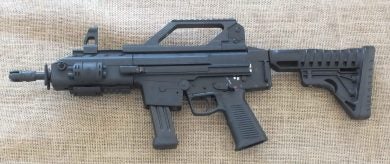The concept of “modular” or “family line” weapons is far from new, being easily found worldwide, but, much more typically, in the Heckler & Koch house. Once you have a sound, functional firing mechanism/operating system combination, chances are that they may be used in a variety of configurations and calibers. Enter the IMBEL -Indústria de Material Bélico do Brasil company. Having developed and placed into production the IA2 family of 5.56x45mm and 7.62x51mm rifles in both selective-fire and semi-auto variants, in addition to being about to certify a .22LR training kit for the smaller-caliber types, the design office of the concern’s Fábrica de Itajubá (Itajubá Factory) is now playing around with derived .40 S&W and 9x19mm submachine-gun designs, plus a .380 ACP semi-auto carbine.
No matter what, the “point-forty” cartridge has for long become a sort of standard ammunition for the Brazilian law enforcement agencies service pistols, with different models from the Taurus and IMBEL stables being in use nationwide. As expected, a similarly-chambered submachine gun would be in order sooner or later, Forjas Taurus eventually succeeding in selling its MT-40 (a joint venture with Chiles’ FAMAE, based on the company’s 9x19mm SAF 9 model) to some local public security forces, including those of Rio de Janeiro and São Paulo States. The weapon, however, was not much appreciated by its users, criticism focusing mainly on the high cyclic rate of fire of about 1,200 rounds per minute. A derivative semi-auto carbine, the CT-40 with a 410mm barrel, was also acquired in some numbers by police and penitentiary guard forces.
In 2010-11, Taurus completed the design of an SMG of its own, the SMT40. After entering production in 2012 and being purchased by some LE forces, the type began to show different types of problems, including reported barrel fissures, material failures, and safety concerns. A widely publicized case was that of 5,931 guns delivered to PMESP – Polícia Militar do Estado de São Paulo (São Paulo State Military Police) and which were quickly removed from use. Still kept in storage, only, the weapons await the settlement of a long dispute between that State’s military police and the manufacturer. A semi-auto-only version, the CTT40C, eventually found use in some police departments, including the PMERJ – Polícia Militar do Estado do Rio de Janeiro (Rio de Janeiro State Military Police), but problems with it have also been reported.
This nebulous background in the supply of .40 S&W buzzguns for the Brazilian market appears to have prompted IMBEL’s Fábrica de Itajubá (Itajubá Factory) to enter this market niche. Rumors that some prototypes were in the preliminary construction and fire testing phases began to circulate early in 2017, and were reinforced during the LAAD Exhibition in Rio de Janeiro in April, but never officially confirmed by the manufacturer. However, in a visit to Itajubá, Minas Gerais State, last August, I was very kindly allowed to take a brief look at some of the completed test examples and, also briefly, fire one of them.

A .40 S&W submachine gun prototype fitted with the new IMBEL optional foldable and adjustable stock (here, in the shortest setting) shows the typical IA2 lower receiver and a new, shortened handguard, the large 5.56x45mm ejection window being evident.
Yes, the gun is immediately identified as an IA2 derivative, since the now-familiar (to the author, at least) lower receiver configuration is there together with two variants of the manufacturer’s more recent polymer stocks. Although shorter than the 5.56x45mm IA2 rifle’s, the polymer handguard confirms the general inheritance of the weapon. Still undesignated, the current prototypes are intended to generally explore the concept, only, while an eventual, final consolidated design incorporating a dedicated, larger-capacity magazine may look a little different. A .380ACP-chambered semi-auto carbine, intended to supply the private security and commercial markets, was shown to me, too, while a 9x19mm variation for military use is also envisaged. Additional details available at this time can be found in the photo captions. My warmest thanks to the most cooperative staff of Fábrica de Itajubá for allowing me to bring this scoop news to you, TFB’s readers. Will try to keep you posted on the program progress.

This SMG prototype uses .40 S&W magazines from other IMBEL models, such as the 16-round unit of the GC MD2 and TC MD6 pistols. If eventually going ahead with the development program, the company will be using staggered-row magazines with 30-or-so rounds.


Author preparing to insert a 16-round pistol magazine into the .40 S&W subgun prototype and firing it at the Fábrica de Itajubá range. Operation is conventional blowback with a closed bolt (hammer + striker).

As currently configured, the .40 S&W prototype has a 200mm barrel (6 grooves, LH, 1:406mm pitch, 3-slot compensator fitted), overall and folded-stock lengths being 820 and 740mm, respectively. Weight of about 3kg to be reduced in production models.

This .380 ACP semi-auto carbine prototype caught the author’s eye due to its, eh, “smart” look resulting from the use of raised iron sights on the top Picattiny rail. Note the prong-type flash hider and 18-round pistol magazine.

As seen from the left side, the same gun shows the use of a fold-flat charging handle (a FAL reminder) and that the polymer stock is of a non-foldable, telescopic model. The 200mm barrel (6 grooves, RH, 1:406mm pitch) gives the 3kg carbine an overall length of 740mm (670mm, stock retracted).
High-res photos? Here: https://imgur.com/a/HFlRN
 Your Privacy Choices
Your Privacy Choices
